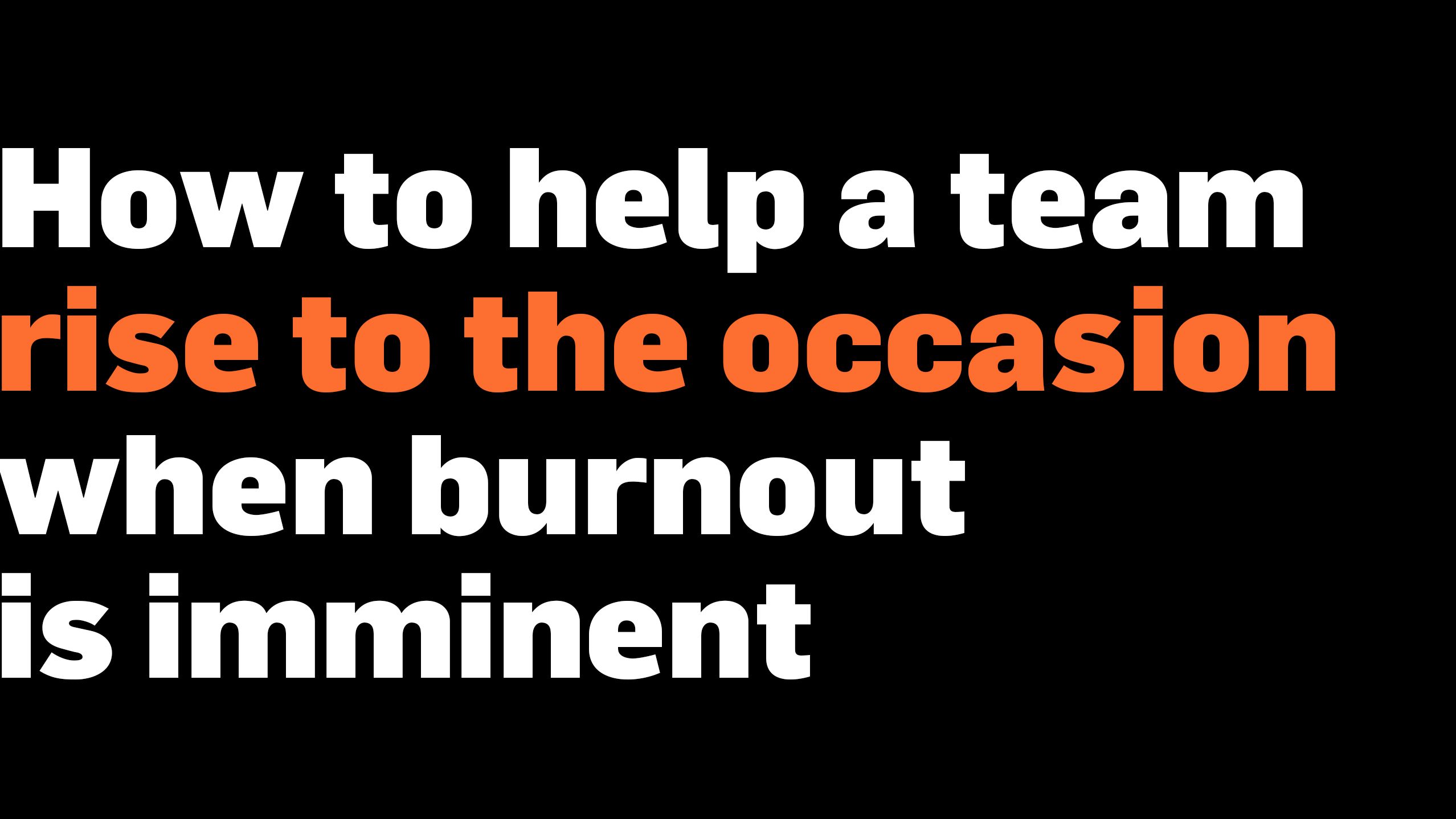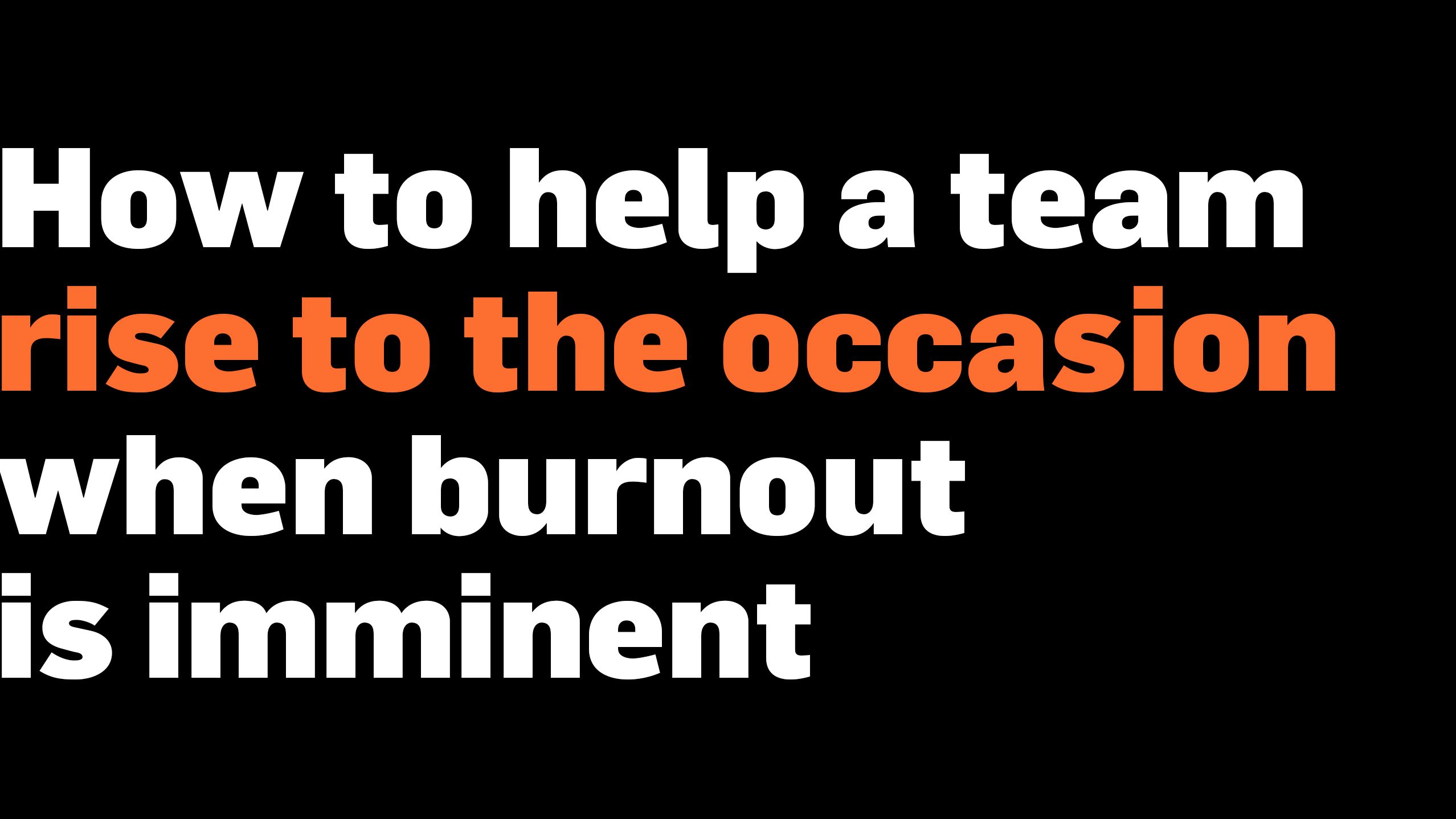

Don't Panic!
What can go wrong will go wrong.

There’s a reason Murphy’s Law never goes out of style—it’s because it’s true. But, if you’re prepared for the absolute worst and trained in the art of disaster, you’ll be prepared to pivot and succeed in the face of challenges.
Brands whose agility got them through digital transformation, privacy regulation, brand safety Armageddon, the pandemic and the deprecation of the cookie know this. They took these seemingly difficult situations and reacted in a way that allowed them to come out on the other side better for it. They have learned how to thrive under tough, ever-evolving conditions.
Of course, it is not just global market changes that can challenge marketers. Sometimes it is issues closer to home: a subject-matter expert who ignores your request to review a document; a campaign that isn’t properly budgeted; a workflow that gets jammed by conflicting priorities; an email that was sent to everyone that was only meant for a select few. Pivots are a part of marketing today. You can see why it pays to be prepared.
So, how do you become a worst-case scenario expert who is prepared for anything? One might say practice, but this is one place where real-world practice does not make perfect. Instead of throwing yourself into the snake pit, we’ve assembled some scenarios and the steps for survival you need to get out in one piece.
While we hope you’ll never have to deal with any of these nightmares, they contain a blueprint in case you do. And hey, if these “nightmares” happen to be just part of a normal day, these survival steps will help you find your way to a sustainable solution. So, put your helmet on, buckle up and get ready to learn how to survive a marketing disaster.



There’s a reason Murphy’s Law never goes out of style—it’s because it’s true. But, if you’re prepared for the absolute worst and trained in the art of disaster, you’ll be prepared to pivot and succeed in the face of challenges.
Brands whose agility got them through digital transformation, privacy regulation, brand safety Armageddon, the pandemic and the deprecation of the cookie know this. They took these seemingly difficult situations and reacted in a way that allowed them to come out on the other side better for it. They have learned how to thrive under tough, ever-evolving conditions.
Of course, it is not just global market changes that can challenge marketers. Sometimes it is issues closer to home: a subject-matter expert who ignores your request to review a document; a campaign that isn’t properly budgeted; a workflow that gets jammed by conflicting priorities; an email that was sent to everyone that was only meant for a select few. Pivots are a part of marketing today. You can see why it pays to be prepared.
So, how do you become a worst-case scenario expert who is prepared for anything? One might say practice, but this is one place where real-world practice does not make perfect. Instead of throwing yourself into the snake pit, we’ve assembled some scenarios and the steps for survival you need to get out in one piece.
While we hope you’ll never have to deal with any of these nightmares, they contain a blueprint in case you do. And hey, if these “nightmares” happen to be just part of a normal day, these survival steps will help you find your way to a sustainable solution. So, put your helmet on, buckle up and get ready to learn how to survive a marketing disaster.

Your business is growing and requests for creative assets have turned from a manageable trickle into a full-on firehose. Trying to manage the deluge leaves you with the feeling that things are falling through the cracks. Did Dave from sales ask for an infographic or was that from your dream last night? Your designer is churning out Facebook ads, but when one request is finished there are 10 more behind it. Your team is putting in their best effort, but it’s become clear that your process for handling huge amounts of creative requests needs some serious help.
STEPS FOR SURVIVAL
1. Create a single form for submitting all creative requests. Make it clear to the rest of the organization that any request that doesn’t come in through this channel won’t be completed. With this single view of requests, you’ll have the end-to-end visibility you need to prioritize work, assign the right resources and track progress through to completion.
2. Go through each item and assign it out to the appropriate team member. Ideally, you’ll have a view of other projects they are working on, so you don’t end up overwhelming anyone. Consider investing in a resource management tool that allows you to see who is available and when, who has the skills for the job, and even forecast out hiring needs based on workloads or types of requests.
3. Streamline your approvals process for items currently in progress and the future. Instead of a messy email chain where someone is always accidentally being left off, use a tool that all approvers have access to and where they can clearly see what needs their approval and when. This tool should also be used to involve the person who requested the item, so they can stay up to date on its progress and feel like a part of the process.
4. Create clear workflows for what happens when a request is completed. It's crucial to use a digital asset management system to create a single source of truth when it comes to your assets. With this in place, you can move on to fine-tuning how assets are managed, distributed and archived. Having one central system that houses all completed assets like this will give you easy access to archived content and the ability to manage updates.



Your business is growing and requests for creative assets have turned from a manageable trickle into a full-on firehose. Trying to manage the deluge leaves you with the feeling that things are falling through the cracks. Did Dave from sales ask for an infographic or was that from your dream last night? Your designer is churning out Facebook ads, but when one request is finished there are 10 more behind it. Your team is putting in their best effort, but it’s become clear that your process for handling huge amounts of creative requests needs some serious help.
STEPS FOR SURVIVAL
1. Create a single form for submitting all creative requests. Make it clear to the rest of the organization that any request that doesn’t come in through this channel won’t be completed. With this single view of requests, you’ll have the end-to-end visibility you need to prioritize work, assign the right resources and track progress through to completion.
2. Go through each item and assign it out to the appropriate team member. Ideally, you’ll have a view of other projects they are working on, so you don’t end up overwhelming anyone. Consider investing in a resource management tool that allows you to see who is available and when, who has the skills for the job, and even forecast out hiring needs based on workloads or types of requests.
3. Streamline your approvals process for items currently in progress and the future. Instead of a messy email chain where someone is always accidentally being left off, use a tool that all approvers have access to and where they can clearly see what needs their approval and when. This tool should also be used to involve the person who requested the item, so they can stay up to date on its progress and feel like a part of the process.
4. Create clear workflows for what happens when a request is completed. It's crucial to use a digital asset management system to create a single source of truth when it comes to your assets. With this in place, you can move on to fine-tuning how assets are managed, distributed and archived. Having one central system that houses all completed assets like this will give you easy access to archived content and the ability to manage updates.

Your charismatic company founder has just majorly screwed up on live TV and you are getting roasted from all sides. Your entire brand is centered around this person, and you need a plan to salvage your brand image while convincing customers your product still deserves a place in their lives.
STEPS FOR SURVIVAL
1. Address what happened head-on. You don’t want to distance yourself from the founder too quickly; this will look disingenuous. Instead, create a communication plan that acknowledges what happened was bad and shows empathy for anyone who was harmed or insulted. Make sure your message stays on-point by keeping a top-down view of all your channels and the communications going out on them.
2. Assess how bad the damage is and if you’ll need to come up with a totally new creative direction, logo and aesthetic. Consider carefully—you likely have a lot of brand equity built up and starting over from scratch might hurt more than help. In this case, it makes more sense to get rid of elements of the brand that have the founder’s image and name and focus on the other areas of your value proposition. Create a “kit of parts” that contains the elements you are going to retain and make them easily accessible to all team members. Everything else outside of these core elements is fluid and subject to change pending your review and if they have the founder in them.
3. Be careful not to neglect the little things as you work to remove the founder from your channels. Pay attention to metadata like page titles, descriptions and image tags, as well as SEO terms and keywords. Make sure that any updated imagery or taglines are also sent to partners who link to or mention your site.
4. Show—don’t tell—the public that you are serious about moving forward. Create and publish a plan with the specific actions you are taking to live up to your new brand promise. Create a pipeline of content that reinforces this promise and make sure your internal communications channels can keep all employees informed and on message.



Your charismatic company founder has just majorly screwed up on live TV and you are getting roasted from all sides. Your entire brand is centered around this person, and you need a plan to salvage your brand image while convincing customers your product still deserves a place in their lives.
STEPS FOR SURVIVAL
1. Address what happened head-on. You don’t want to distance yourself from the founder too quickly; this will look disingenuous. Instead, create a communication plan that acknowledges what happened was bad and shows empathy for anyone who was harmed or insulted. Make sure your message stays on-point by keeping a top-down view of all your channels and the communications going out on them.
2. Assess how bad the damage is and if you’ll need to come up with a totally new creative direction, logo and aesthetic. Consider carefully—you likely have a lot of brand equity built up and starting over from scratch might hurt more than help. In this case, it makes more sense to get rid of elements of the brand that have the founder’s image and name and focus on the other areas of your value proposition. Create a “kit of parts” that contains the elements you are going to retain and make them easily accessible to all team members. Everything else outside of these core elements is fluid and subject to change pending your review and if they have the founder in them.
3. Be careful not to neglect the little things as you work to remove the founder from your channels. Pay attention to metadata like page titles, descriptions and image tags, as well as SEO terms and keywords. Make sure that any updated imagery or taglines are also sent to partners who link to or mention your site.
4. Show—don’t tell—the public that you are serious about moving forward. Create and publish a plan with the specific actions you are taking to live up to your new brand promise. Create a pipeline of content that reinforces this promise and make sure your internal communications channels can keep all employees informed and on message.

It’s 10 a.m. and you’re just getting into your flow when an email comes in: Your CMO wants a performance report on a recent campaign by the end of the day. This is going to require an all-hands-on-deck scramble, because you can’t find any of the results of your campaign—your metrics and content are scattered and disconnected. Can you pull it all together in time and create a process so that it doesn’t happen again?
STEPS FOR SURVIVAL
1. You need to answer the request today. Also recognize that it’s likely to happen again and you want to set yourself up to provide reports at the drop of a hat without having to scramble. So, first you need to pull everything you have into one single, sustainable source of truth. Even if it’s messy now, creating a place where all your data is aggregated will make it more manageable.
2. Assign team members to gather metrics from all the channels that were used, now that all of your results are in a single repository. Make sure your assignments and tasks are clear and that the deliverables are understood.
3. Buy everyone pizza. It’s going to be a long day.
4. Check back into your data repository to see what progress has been made (without disrupting anyone’s work) and follow up with individual team members if you see holes.
5. Have everyone upload their finished pieces of the report into a central system. Double-check your numbers, format them and send off the finished report to your CMO.
6. Take a deep breath and examine why your data got so messy in the first place. Are you lacking technology that can help streamline reporting and prevent silos from forming? Is your central source of truth not easy enough to access or work with?



It’s 10 a.m. and you’re just getting into your flow when an email comes in: Your CMO wants a performance report on a recent campaign by the end of the day. This is going to require an all-hands-on-deck scramble, because you can’t find any of the results of your campaign—your metrics and content are scattered and disconnected. Can you pull it all together in time and create a process so that it doesn’t happen again?
STEPS FOR SURVIVAL
1. You need to answer the request today. Also recognize that it’s likely to happen again and you want to set yourself up to provide reports at the drop of a hat without having to scramble. So, first you need to pull everything you have into one single, sustainable source of truth. Even if it’s messy now, creating a place where all your data is aggregated will make it more manageable.
2. Assign team members to gather metrics from all the channels that were used, now that all of your results are in a single repository. Make sure your assignments and tasks are clear and that the deliverables are understood.
3. Buy everyone pizza. It’s going to be a long day.
4. Check back into your data repository to see what progress has been made (without disrupting anyone’s work) and follow up with individual team members if you see holes.
5. Have everyone upload their finished pieces of the report into a central system. Double-check your numbers, format them and send off the finished report to your CMO.
6. Take a deep breath and examine why your data got so messy in the first place. Are you lacking technology that can help streamline reporting and prevent silos from forming? Is your central source of truth not easy enough to access or work with?

Your creative team pitched a campaign that is set to redefine your brand. You’re firing on all cylinders to get it off the ground when your finance director sends a not-so-friendly email notifying you that you’re at risk of blowing your budget.
STEPS FOR SURVIVAL
1. Get a top-down view of what resources are left and what elements of the campaign still need to be created. The best way to do this is to gather all information related to resources and budgets and compile it into a single location. This will give you better visibility and tracking capabilities.
2. Obsessively track any dollars going out by inputting every penny spent into a single dashboard. With this in place, you’ll be able to clearly see where the most money is being spent, identify if a mistake was made, and pull back on any unnecessary expenditures.
3. Forecast out the needs for the rest of the project using this single source of spending truth. Having a view of what needs to be done and its associated costs will help you feel calm and in control and will help with day-to-day decision-making.
4. Get your creative leaders access to your tracking and forecasting so they can match their work with the available resources, monitor budgets across projects in real time and track how actuals are differentiated from your original plan. With everyone in the know about what resources you have left, you can work as a team to maximize the impact of your campaign.
5. You crushed the campaign and through some sorcery and hard work, came in under budget. Give everyone the next morning off to start shopping for outfits to wear when you kill it at Cannes.



Your creative team pitched a campaign that is set to redefine your brand. You’re firing on all cylinders to get it off the ground when your finance director sends a not-so-friendly email notifying you that you’re at risk of blowing your budget.
STEPS FOR SURVIVAL
1. Get a top-down view of what resources are left and what elements of the campaign still need to be created. The best way to do this is to gather all information related to resources and budgets and compile it into a single location. This will give you better visibility and tracking capabilities.
2. Obsessively track any dollars going out by inputting every penny spent into a single dashboard. With this in place, you’ll be able to clearly see where the most money is being spent, identify if a mistake was made, and pull back on any unnecessary expenditures.
3. Forecast out the needs for the rest of the project using this single source of spending truth. Having a view of what needs to be done and its associated costs will help you feel calm and in control and will help with day-to-day decision-making.
4. Get your creative leaders access to your tracking and forecasting so they can match their work with the available resources, monitor budgets across projects in real time and track how actuals are differentiated from your original plan. With everyone in the know about what resources you have left, you can work as a team to maximize the impact of your campaign.
5. You crushed the campaign and through some sorcery and hard work, came in under budget. Give everyone the next morning off to start shopping for outfits to wear when you kill it at Cannes.

Your typically awesome and obsessively on-time marketing team has suddenly been missing deadlines all month. A group memo arrives where they voice their mounting frustration at the fact that they never know what the next week or month will hold. Work is piling up, other departments are complaining about their lack of assets and you need to increase team morale, stat.
STEPS FOR SURVIVAL
1. Start by working to understand why work is slowing. Are you lacking clear priorities? Is your team's capacity being overtaxed? Are you lacking resources? Getting to the root of the problem is the only way to solve it. Once the problem is understood, communicate to stakeholders in other departments what your team’s real capacity is and make it clear that the problem won’t be solved by asking them to work crazy hours or come in on weekends.
2. Create a calendar for the entire team that includes group and individual deadlines and deliverables. Create weekly, monthly and yearly versions so everyone can plan for what’s coming down the pipeline and feel mentally prepared for big projects.
3. Layer this calendar with a tool for resource management that allows you to forecast what resources will be available and who has the bandwidth for what. With this integrated approach, you’ll be able to understand workloads and balance deliverables with your teams’ availability. PTO should be included, so that no one feels like their time off isn’t being prioritized.
4. Set up automated reminders for project deadlines and use color-coding to indicate priorities.
5. Make sure everyone has the resources they need to deliver on these deadlines by integrating your resource bank. Everyone should be able to clearly see who's been assigned, request the right people for the job and get a real-time preview of the impact of changes as you move through the project lifecycle.
6. Make sure you have a clear “why” for every project or deadline as resources are assigned. Working towards a common goal will help bring everyone together and give them more of a sense of purpose. By aligning your people to the work that matters most, you can build the best team for the job and unlock their potential.



Your typically awesome and obsessively on-time marketing team has suddenly been missing deadlines all month. A group memo arrives where they voice their mounting frustration at the fact that they never know what the next week or month will hold. Work is piling up, other departments are complaining about their lack of assets and you need to increase team morale, stat.
STEPS FOR SURVIVAL
1. Start by working to understand why work is slowing. Are you lacking clear priorities? Is your team's capacity being overtaxed? Are you lacking resources? Getting to the root of the problem is the only way to solve it. Once the problem is understood, communicate to stakeholders in other departments what your team’s real capacity is and make it clear that the problem won’t be solved by asking them to work crazy hours or come in on weekends.
2. Create a calendar for the entire team that includes group and individual deadlines and deliverables. Create weekly, monthly and yearly versions so everyone can plan for what’s coming down the pipeline and feel mentally prepared for big projects.
3. Layer this calendar with a tool for resource management that allows you to forecast what resources will be available and who has the bandwidth for what. With this integrated approach, you’ll be able to understand workloads and balance deliverables with your teams’ availability. PTO should be included, so that no one feels like their time off isn’t being prioritized.
4. Set up automated reminders for project deadlines and use color-coding to indicate priorities.
5. Make sure everyone has the resources they need to deliver on these deadlines by integrating your resource bank. Everyone should be able to clearly see who's been assigned, request the right people for the job and get a real-time preview of the impact of changes as you move through the project lifecycle.
6. Make sure you have a clear “why” for every project or deadline as resources are assigned. Working towards a common goal will help bring everyone together and give them more of a sense of purpose. By aligning your people to the work that matters most, you can build the best team for the job and unlock their potential.
About Smartsheet
Smartsheet is a dynamic workspace that empowers teams to manage projects, automate workflows and rapidly build new solutions—using no-code tools they love, and backed by the control and security IT needs. Smartsheet for Marketing empowers top marketers and creative agencies to align their teams, build flexible workflows and report on all their initiatives in one place.



 Built with Shorthand
Built with Shorthand





